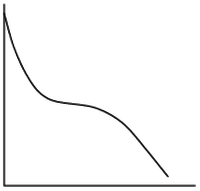Words - Tables - Graphs
Below are 4 verbal descriptions, 3 graphs, and 3 tables of values. Match each of the following descriptions with an appropriate graph and table of values. Create the missing graph and the missing table of values.
1. The weight of your jumbo box of cereal decreases by an equal amount every week.
2. The value of the bicycle depreciated rapidly at first, but its value declined more slowly as time went on.
3. The tennis ball is dropped off the roof of a skyscraper.
4. For a while it looked like the decline in profits was slowing down, but then they began declining more rapidly.
A.
|
x |
0 |
1 |
2 |
3 |
4 |
5 |
|
y |
400 |
384 |
336 |
256 |
144 |
0 |
B.
|
x |
0 |
1 |
2 |
3 |
4 |
5 |
|
y |
400 |
184 |
98 |
63 |
49 |
43 |
C.
|
x |
0 |
1 |
2 |
3 |
4 |
5 |
|
y |
400 |
253 |
218 |
216 |
181 |
34 |




